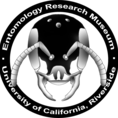Loan Policy
Loan requests for parasitic Hymenoptera should be directed to Dr. Triapitsyn, all other requests should be directed to Dr. Yanega.
Conditions and practices regarding loans from the UCR Entomology Research Museum (ERM), hereafter referred to as "the Museum", as understood and agreed to by recipients thereof:
- When materials are received by borrowers, the duplicate loan invoice (enclosed with the specimens) should be signed and returned immediately to the Museum. Each loan is given a unique number, to be used in all correspondence referring to the loan.
- Loans are made for a stipulated period of time, typically two years, and may be extended in appropriate circumstances upon written application to and approval by the Museum (No specimens should be returned during December). The Museum reserves the right to recall any of its material at any time.
- Loans are not transferable and may not be relocated without approval from the Museum.
- Borrowers should not assume that they can retain any specimens unless prior permission is obtained, though permission is usually granted upon request. Primary types should always be returned unless specifically exempted. If the borrower has all of the Museum's holdings of a given higher taxon, then we request the return of all uniques, at least one specimen of each sex, caste, or major variant for each species represented, and, if possible, one specimen from each discrete locality (i.e., specimens retained should be duplicates in all possible respects).
- If the borrower has in mind a specific repository other than the ERM, then this should be communicated to and agreed upon by the Museum in advance. Otherwise, types designated from our material should be returned - preferably by registered mail - to the Museum as soon as convenient.
- If specimens to be retained permanently have a UCRC database number label, and the retaining institution wishes to assign their own GUID, the UCR label should be removed and returned to the museum. Note that most specimens bearing UCRC GUIDs have associated data that does not appear on the specimen labels (e.g., georeference data), so we strongly advise against this; we likewise request that any publications citing data from, or mapping such specimens, use the data from the UCR database, rather than verbatim citation of the label data, which may be incomplete or erroneous.
- Borrowers who wish to dissect any specimen are required to do so in such a way that the specimen suffers the least possible damage, and must ensure that parts dissected out are correctly preserved and associated with the rest of the specimen. DNA sampling is allowed, but we request that non-destructive techniques be used (e.g., only a tarsus, or at most a leg). Specimens completely destroyed in order to do genetic analysis are considered as "gifts", but sequence data should be returned to the Museum in some form (publication or otherwise).
- Borrowers should attach determination labels to every non-databased specimen returned or, if this is impractical, the material returned should be arranged to show clearly to which specimens a given determination applies. If the borrower has been sent a specimen-level databased inventory, the Museum should be given a duplicate of the edited database file to incorporate into the Museum's primary database.
- Acknowledgment in any paper resulting from the study of materials borrowed from the Museum would be appreciated as well as a reprint(s) of such paper(s).
- Additional special conditions may apply on an individual basis.

